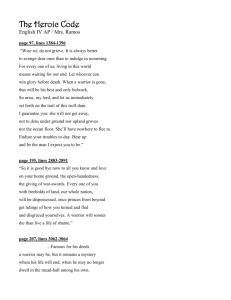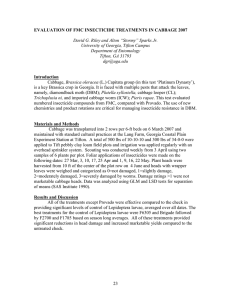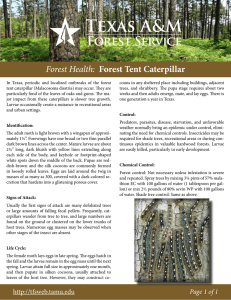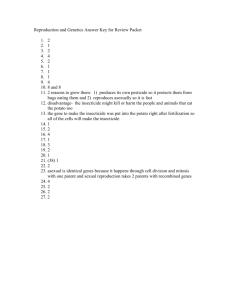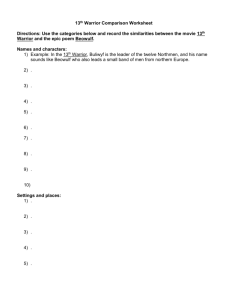BACILLUS THRUINGIENSIS 2007 Extension Research Report Insect Management
advertisement
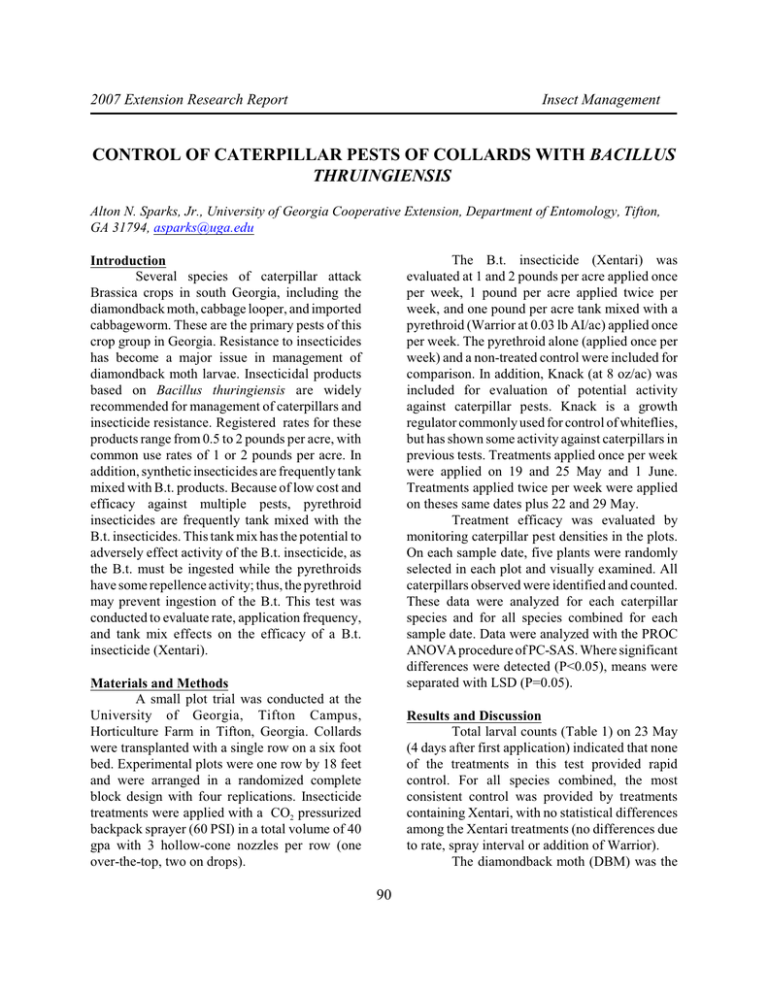
2007 Extension Research Report Insect Management CONTROL OF CATERPILLAR PESTS OF COLLARDS WITH BACILLUS THRUINGIENSIS Alton N. Sparks, Jr., University of Georgia Cooperative Extension, Department of Entomology, Tifton, GA 31794, asparks@uga.edu The B.t. insecticide (Xentari) was evaluated at 1 and 2 pounds per acre applied once per week, 1 pound per acre applied twice per week, and one pound per acre tank mixed with a pyrethroid (Warrior at 0.03 lb AI/ac) applied once per week. The pyrethroid alone (applied once per week) and a non-treated control were included for comparison. In addition, Knack (at 8 oz/ac) was included for evaluation of potential activity against caterpillar pests. Knack is a growth regulator commonly used for control of whiteflies, but has shown some activity against caterpillars in previous tests. Treatments applied once per week were applied on 19 and 25 May and 1 June. Treatments applied twice per week were applied on theses same dates plus 22 and 29 May. Treatment efficacy was evaluated by monitoring caterpillar pest densities in the plots. On each sample date, five plants were randomly selected in each plot and visually examined. All caterpillars observed were identified and counted. These data were analyzed for each caterpillar species and for all species combined for each sample date. Data were analyzed with the PROC ANOVA procedure of PC-SAS. Where significant differences were detected (P<0.05), means were separated with LSD (P=0.05). Introduction Several species of caterpillar attack Brassica crops in south Georgia, including the diamondback moth, cabbage looper, and imported cabbageworm. These are the primary pests of this crop group in Georgia. Resistance to insecticides has become a major issue in management of diamondback moth larvae. Insecticidal products based on Bacillus thuringiensis are widely recommended for management of caterpillars and insecticide resistance. Registered rates for these products range from 0.5 to 2 pounds per acre, with common use rates of 1 or 2 pounds per acre. In addition, synthetic insecticides are frequently tank mixed with B.t. products. Because of low cost and efficacy against multiple pests, pyrethroid insecticides are frequently tank mixed with the B.t. insecticides. This tank mix has the potential to adversely effect activity of the B.t. insecticide, as the B.t. must be ingested while the pyrethroids have some repellence activity; thus, the pyrethroid may prevent ingestion of the B.t. This test was conducted to evaluate rate, application frequency, and tank mix effects on the efficacy of a B.t. insecticide (Xentari). Materials and Methods A small plot trial was conducted at the University of Georgia, Tifton Campus, Horticulture Farm in Tifton, Georgia. Collards were transplanted with a single row on a six foot bed. Experimental plots were one row by 18 feet and were arranged in a randomized complete block design with four replications. Insecticide treatments were applied with a CO2 pressurized backpack sprayer (60 PSI) in a total volume of 40 gpa with 3 hollow-cone nozzles per row (one over-the-top, two on drops). Results and Discussion Total larval counts (Table 1) on 23 May (4 days after first application) indicated that none of the treatments in this test provided rapid control. For all species combined, the most consistent control was provided by treatments containing Xentari, with no statistical differences among the Xentari treatments (no differences due to rate, spray interval or addition of Warrior). The diamondback moth (DBM) was the 90 most abundant caterpillar species on each sample date (based on populations in the check, Table 2). As with the total larval counts, no differences were detected on the first sample date and treatments containing Xentari provided the most consistent control thereafter. Treatment with Warrior actually resulted in increased DBM populations on two of the last three sample dates, as compared to the check. Knack appeared to provide some suppression of DBM populations, but not until well after the second application. Looper and Imported cabbageworm (ICW) larvae were at very low densities at initiation of this test, but increased near the end of the test. All insecticide treatments provided similar control of ICW, with the exception of Knack which showed poor control on the last sample date. Looper densities were relatively low throughout the test and differences were inconsistent. While the data in this particular test showed no significant rate, timing or tank mix effects on the B.t. insecticide, knowledge of this products activity and persistence allow for some general conclusions concerning its use. First of all, the data does indicate that the one pound rate was as efficacious as the two pound rate. Thus, given similar timing of applications, the higher rate did not increase control. A major limitation of control with B.t. products is the short residual activity. The B.t. endotoxins actually applied with an application are highly susceptible to photodegradation and last a matter of only hours with exposure to sunlight. Thus, timing of application is critical to maximize control. If these products are being used in a ‘preventative’ manner, with frequent scheduled applications, proper timing is more likely to occur with two one pound applications per week as compared with a single two pound application. Finally, although the tank mix with the pyrethroid insecticide did not significantly effect efficacy in this test, the fact that diamondback moth larvae densities were significantly higher in the pyrethroid only plots suggests that pyrethroids should not be used in fields with significant diamondback moth populations. Table 1. Total number of caterpillars per five plants, B.t. efficacy trial on collards, Tifton, Georgia, 2006. Number of larvae per 5 plants (all species combined) Treatment 23 May 26 May 31 May 5 June 8.5 a 11.8 b 35.8 a 20.0 a Warrior 13.8 a 17.0 a 18.8 b 17.0 a Knack 9.8 a 11.3 b 10.0 b 17.3 a Xentari 1 lb 9.3 a 5.3 c 8.8 b 7.0 b Xentari 2 lb 6.8 a 2.8 c 11.8 b 8.5 b 11.8 a 5.8 c 6.5 b 5.3 b Check Xentari 2x/wk Xentari+Warrior 5.8 a 4.8 c 10.0 b 7.5 b Numbers within columns followed by the same letter are not significantly different (LSD; P=0.05) 91 Table 2. Larval densities by species, B.T. efficacy trial on collards, Tifton, Georgia, 2006. Number of larvae per 5 plants Treatment 23 May 26 May 31 May 5 June 8.5 a 11.5 b 21.0 a 9.8 b Warrior 13.8 a 17.0 a 17.5 ab 16.5 a Knack 9.8 a 10.5 b 5.5 c 7.0 bc Xentari 1 lb 9.3 a 5.3 c 5.8 c 4.3 c Xentari 2 lb 6.3 a 2.8 c 8.5 bc 5.3 bc 11.5 a 5.8 c 5.8 c 3.0 c 5.8 a 4.0 c 8.8 bc 6.3 bc Check 0.0 a 0.0 a 1.5 a 2.5 a Warrior 0.0 a 0.0 a 0.0 c 0.5 a Knack 0.0 a 0.0 a 1.3 ab 2.0 a Xentari 1 lb 0.0 a 0.0 a 0.5 bc 2.0 a Xentari 2 lb 0.3 a 0.0 a 1.3 ab 2.3 a Xentari 2x/wk 0.0 a 0.0 a 0.0 c 1.8 a Xentari+Warrior 0.0 a 0.8 a 0.8 abc 1.0 a Diamondback moth larvae Check Xentari 2x/wk Xentari+Warrior Cabbage looper larvae Imported cabbageworm larvae Check 0.0 a 0.3 a 13.3 a 7.8 a Warrior 0.0 a 0.0 a 1.3 b 0.0 b Knack 0.0 a 0.8 a 3.3 b 8.3 a Xentari 1 lb 0.0 a 0.0 a 2.5 b 0.8 b Xentari 2 lb 0.3 a 0.0 a 2.0 b 1.0 b Xentari 2x/wk 0.3 a 0.0 a 0.8 b 0.5 b Xentari+Warrior 0.0 a 0.0 a 0.5 b 0.3 b Numbers within columns and caterpillar species followed by the same letter are not significantly different (LSD; P=0.05). 92
